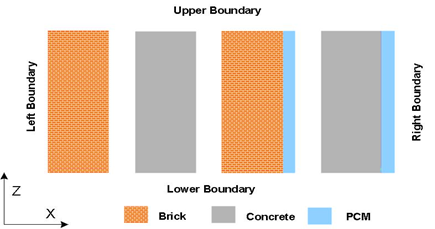Numerical Study of Integrating the Phase Change Material with Building Envelop for Improved Indoor Thermal Comfort
DOI:
https://doi.org/10.58564/IJSER.3.3.2024.235Keywords:
Phase Change Materials, Latent Heat, Sensible Heat, Numerical Methods, and Thermal ComfortAbstract
This research simulates the temperature dynamics of the phase change material PCM using the new approach to calculate heat capacity, supported by advanced, efficient explicit numerical methods. The study examines many scenarios for building wall geometries and boundary conditions by controlling the heat loads and ensuring comfortable interior temperatures. Paraffin wax, selected for its distinct melting temperatures and latent heat capacities, is used as the PCM. The study consistently demonstrates the effectiveness of PCMs in decreasing the heat transfer indoors of the building, regardless of the wall material. This research helps to understand the PCMs' behaviour using the Effective Heat Capacity model, offering valuable insights for energy-efficient building design and highlighting the critical role of selecting suitable PCMs in construction.
References
[1] J. L. A. C. N. U. et al. Rose, "NUMERICAL METHOD FOR CALCULATING LATENT HEAT STORAGE IN CONSTRUCTIONS CONTAINING PHASE CHANGE MATERIAL," Build. Simul., no. Eleventh International IBPSA Conference Glasgow, Scotland July 27-30, 2009, pp. 400–407, 2009.
[2] A. D. Solomon, "An easily computable solution to a two-phase Stefan problem," Sol. Energy, vol. 23, no. 6, pp. 525–528, Jan. 1979, doi: 10.1016/0038-092X(79)90077-X.
[3] M. Cui, C. Zhang, B. Zhang, B. Xu, H. Peng, and X. wei Gao, "Numerical solution of phase change heat transfer problems by effective heat capacity model and element differential method," J. Comput. Sci., vol. 60, p. 101593, Apr. 2022, doi: 10.1016/J.JOCS.2022.101593.
[4] X. Jin, H. Hu, X. Shi, X. Zhou, and X. Zhang, "Comparison of two numerical heat transfer models for phase change material board," Appl. Therm. Eng., vol. 128, pp. 1331–1339, Jan. 2018, doi: 10.1016/J.APPLTHERMALENG.2017.09.015.
[5] Y. Zhang, "Modified computational methods using effective heat capacity model for the thermal evaluation of PCM outfitted walls," Int. Commun. Heat Mass Transf., vol. 108, p. 104278, Nov. 2019, doi: 10.1016/J.ICHEATMASSTRANSFER.2019.104278.
[6] H. K. Jalghaf, E. Kovács, and B. Bolló, "Comparison of Old and New Stable Explicit Methods for Heat Conduction, Convection, and Radiation in an Insulated Wall with Thermal Bridging," Buildings, vol. 12, no. 9, pp. 1–26, 2022, doi: 10.3390/buildings12091365.
[7] Á. Nagy, M. Saleh, I. Omle, H. Kareem, and E. Kovács, "New Stable, Explicit, Shifted-Hopscotch Algorithms for the Heat Equation," Math. Comput. Appl., vol. 26, no. 3, p. 61, 2021, doi: 10.3390/mca26030061.
[8] Á. Nagy, I. Omle, H. Kareem, E. Kovács, I. F. Barna, and G. Bognar, "Stable, Explicit, Leapfrog-Hopscotch Algorithms for the Diffusion Equation," Computation, vol. 9, no. 8, p. 92, 2021.
[9] K. Kant, A. Shukla, and A. Sharma, "Numerical simulation of building wall incorporating phase change material for cooling load reduction," Energy Clim. Chang., vol. 1, p. 100008, 2020, doi: https://doi.org/10.1016/j.egycc.2020.100008.

Downloads
Published
How to Cite
Issue
Section
License
Copyright (c) 2024 Muwafaq Shyaa Alwan, Humam Kareem Jalghaf , Endre Kovács

This work is licensed under a Creative Commons Attribution-ShareAlike 4.0 International License.
Deprecated: json_decode(): Passing null to parameter #1 ($json) of type string is deprecated in /var/www/vhosts/ijser.aliraqia.edu.iq/httpdocs/plugins/generic/citations/CitationsPlugin.inc.php on line 49









